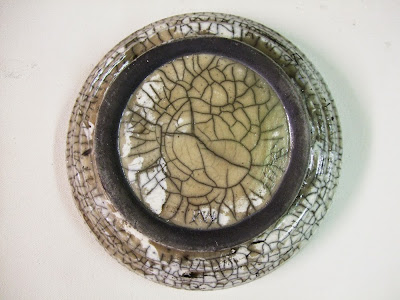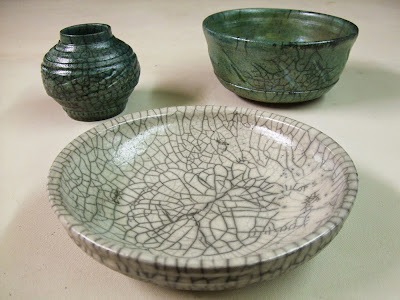Here are some pieces that were fired, raku style, last night during a free workshop at MC3 (611 Main Street, Winnipeg). The green glaze is called Oil Lustre. The white glaze is Middlebrook's White Crackle. I'm not sure what the blue is called.

The clay body for this vase is called Danish White w/ Sand WC-842.
Make sure not to throw too thin and don't make things intended for food use.
Pieces that are very thin, might not survive the thermal shock portion of raku firing.
Pieces that craze are not food safe, as they have nice little fissures where bacteria can grow.

The blue glaze was intended for flashing, to produce bursts or flashes of random colours during the reduction stage of the raku process. I was more interested in the crazing (crackled) aspect, however. To achieve more crazing than flashing in this piece, I exposed it to open air after being yanked from the fire, before placing it into a reduction chamber. The crazing was caused by the thermal shock of going from an 1800 degree F kiln to the 50 degree F outdoor air.

Raku firing involves:
1. heating glazed items to 1800 degrees F
2. placing them into a reduction chamber
3. cooling them in a water bath
This is what the pieces looked like after their water bath. Typically, you would scrub them down with a fine steel wool, baking soda, and water, to remove all of the soot from the reduction chamber.

As you can see in this image, any clay that is not
glazed will turn black. This occurs in the reduction chamber portion of the raku process. These items were placed in metal garbage cans lined with news paper and flax. They were put in the cans, glowing yellow hot (straight from the kiln), or after a brief rest for the sake of producing crazing. Inside the cans, the flax and paper ignite upon contact with the super heated object. These flames give some glazes their unique flashings. After the objects are placed in the cans, the cans are sealed tight, allowing the fire to consume the oxygen, making unglazed surfaces turn black.
Here's how they looked, after being scrubbed clean:
Big thanks to MC3, Elise Nadeau, and Dawn Chaput for running the workshop! Also, thanks to my best friend Aileen Zubriski for applying the glaze to the plant pot, seen in the top right hand of this last image. xoxo




No comments:
Post a Comment